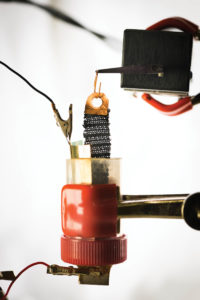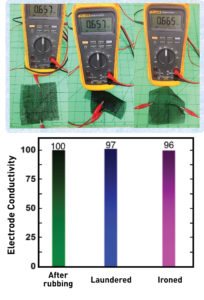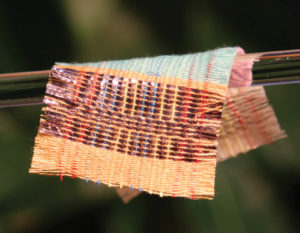
Back in the day, a telephone was expected to perform a limited number of functions: alert you when someone was trying to reach you and connect you to those you were trying to reach. Technology advanced and phones became more portable. The same sort of process is happening to fabrics and fibers.
The possibility of smartening them up has captured the imagination of researchers and manufacturers who see these materials as the ideal platforms for harvesting energy, turning motion (human and that of the natural world) into electricity that can be utilized to power devices, help move limbs, provide heat and light, and in general free users from electrical outlets. Although in the majority of cases these efforts are still very much works in progress, advancements and discoveries are bringing the future closer. There’s a great deal of ongoing research dedicated to transforming textiles into powerful products.
Power to Go
Turning textiles into power-generating, electronically active materials is an objective that Dr. Trisha L. Andrew, assistant professor of chemistry at the University of Massachusetts, Amherst, has set her sights on. Along with other researchers, Andrew, also director of the university’s Wearable Electronics Lab, is seeking to make wearable electronic clothing—light jackets, workout or loungewear, heated gloves or other “thermal-regulated” items, and joint support products like elbow or knee braces—that feels very similar, if not identical to, the conventional versions.

“We are establishing the materials chemistry needed to take any commercial, off-the-shelf textile or fabric and transform it into electronically active circuit elements,” says Andrew. “The vapor phase chemistry in which my lab specializes is uniquely insensitive to the surface treatment/yarn composition and colorization of the starting fabric. So, we simply choose fabrics that are widely available [most commonly cotton, linen, nylon and silk], breathable and feel good to the touch.”
Andrew describes vapor phase chemistry as “a solvent-free process where a chemical reaction is conducted in the gas phase. The reacting species—in our case, two components—are volatilized and separately introduced as vapors into a reaction chamber where they meet and participate in a desired chemical reaction to form polymers.”
As Andrew explains—and as anyone who has scuffed feet across a carpet with the purpose of delivering a small electric jolt to an unsuspecting victim knows—surface charge is created anytime we “touch a surface or force contact between two surfaces.” Although we remain generally unaware of it, pulling on, tugging at or patting our clothes also generates a small surface charge/electrical current through the friction caused by moving against a different material.
“Triboelectric generators are a new kind of electronic device that convert surface charge into storable power,” Andrew adds. “Efforts to improve the electrical performance of triboelectric generators simply involve trying to increase the total surface area of the contacting surfaces. Because we constantly tug, pat and stretch our clothes as we move around, garments are perfectly suited to be transformed into triboelectric generators.”
Finding the right coatings that can assist in this transformation, turning fabrics, threads or yarns into surfaces that can hold on to a sizable amount of surface charge after contact, is key, says Andrew.
“We need to create our own customized surface treatments for triboelectric textiles so that any fabrics that have not been pretreated are usable,” she says.

Harnessing Motion
Dr. Zhong Lin Wang, professor at the Georgia Institute of Technology in Atlanta, is involved in several projects utilizing textiles to harvest or generate energy. One such effort involves several aspects of nano-energy; that is, the energy required to run small electronics, such as a smart watch or a gas/chemical sensor or a health monitor. Another is harvesting energy via floating nets, generating electricity from ocean waves.
“The first project is to use human motion for [powering or charging] small electronics, which [resulted in] the birth of the nanogenerators,” says Wang. “We used three effects for such purposes: piezoelectric, pyroelectric and triboelectric effect. The first two effects gave relatively low efficiency and also cost more, so that we mainly focus on the triboelectric effect.”
The idea of using fabric to generate power goes back to 2007, using materials that self-generated a voltage when compressed along a specific direction, says Wang. The effort was advanced further in 2011, with the invention of the triboelectric nanogenerator, which works for any material—papers, fabrics, plastics and so on—resulting in almost unlimited material options, says Wang, noting that, as expected, some materials work better than others. Also a plus is that, with the triboelectric nanogenerator, the cost is low and fabrication easy.
“The floating nets idea was created to use triboelectric nanogenerators for collecting the energy from waves,” says Wang. “This project is on the way and our results show promise that we could provide an effective way for harvesting water-wave energy at an unprecedented efficiency.”
Still, with this project, there have been some difficulties they’ve encountered, one being the device’s stability. The other is packaging technology, meaning that the entire device must be packed to prevent the infiltration of water and moisture while still allowing it to work sustainably.
“Kinetic energy is basically body-motion energy; so is water-wave energy,” says Wang. “Such energy can serve as an effective power source if it can be efficiently harvested. I anticipate that both fabric-based and water-wave-based energy harvesting can make huge progress in the near future.”
Fabric Muscles
Facilitating human motion through fabrics and fibers—creating textile muscles or exoskeletons—is a passion of Dr. Edwin Jager, associate professor, Division of Sensor and Actuator Systems, Department of Physics, Chemistry and Biology, Linköping University in Linköping, Sweden.
A collaboration with his friend and former colleague Dr. Nils-Krister Persson, with the University of Borås, Sweden, has led to the development of textile muscles using both knitted and woven fabric. The material they selected for this effort is Lyocell, a cellulose-based yarn, preferred because of its green qualities and its potential for replacing oil-based yarns and textiles. They coated this fabric with their electroactive polymer (polypyrrole) through a two-step process, says Jager, adding that Lyocell also has good adhesive properties to the electroactive polymers.
“In the first step, we made the fabric conductive by coating it in a thin layer of the conductive polymer, PEDOT [poly (3,4-ethylenedioxythiophene)], using a process similar to dying,” Jager explains. “In the second step, we used electrochemical deposition—similar to electroplating—to apply a thicker layer of the electroactive polymer polypyrrole, which provides the electro-mechanical properties.”
Jager and Persson have experimented with various plain-weave fabrics, testing the parallel assembly of the single yarns, in an effort to learn which weave arrangement would increase the textile’s force. They determined that a weave six yarns wide delivered six times more force than a single yarn, while a weave 12 yarns wide resulted in 12 times more force than a single yarn.
“In the knitted fabric, we instead accomplished strain amplification,” Jager says. “Using a knitted fabric resulted in 53 times more strain [elongation] as compared to a single yarn of the same material and coated with the same electroactive polymer.”
Jager says he’s been exploring the possibility of amplifying output force of electroactive polymers through the parallel assembling of thin sheets or thin fibers for years. This led him to discussions with Persson, who was working on smart textiles, primarily as sensors, about the likelihood of integrating textile processing with electroactive polymers. Woven textiles in particular offered an efficient, cost-effective option for the parallel assembling of yarns, one that would allow for future manufacturing of electroactive actuators.
After this discovery, the pair began investigating other textile technologies, ultimately landing on weaving for parallel assembly and force amplification and on knitting for strain amplification. In their latest studies, all improvements in force and strain have been determined by the textile’s construction—weave or knitwear—with weaves delivering more force and knitwear more strain. (They did not attempt to achieve improvements at that time through optimizing the electroactive polymer material.)
“But we do not yet know the effect of the different weaves or different knitwear on performance,” Jager says. “This work is ongoing. We’re currently investigating these effects in more detail. Our goal is to be able to design a specific strain and/or force beforehand by selecting a specific textile structure.”
Another consideration is that currently, the materials must be operated in a salt solution; Jager says they’re working on a dry-state version of the technology, which they hope to be able to reveal soon.
“We want to learn more about the various textile constructions and their effect on performance,” Jager says. “Also, we will now optimize the electroactive polymer material to further improve the performance. We hope to be able to integrate the textile actuators in otherwise passive fabrics and thereafter integrate them into items of clothing to provide extra force to the wearer.”
Smarter Wearables
Myant Inc. in Toronto, Canada, makes a variety of battery-operated, rechargeable, reflective/enhanced-visibility products, such as light-powered harnesses, hoodies and jackets. According to its website, the company’s mission is to “integrate technology into everyday apparel, creating a continuous digital presence to better connect, enhance and protect humanity.”

The company also provides R&D funding and manufacturing facilities to various research groups across North America, supporting research into advanced materials, advanced manufacturing in textiles, biosensors, functionalized textiles, nanotechnology and related functions. An area of interest is reactive and conductive yarns that can be integrated into textiles that distribute and collect power from garments, with the emphasis on wearable technology/smart clothing.
For this effort, the company primarily uses silver-based conductive yarns, deploying them for sensing, heat and power transmission, says Milad Afshar, director of energy harvesting and storage.
“We believe the future of smart textiles is completely fiber-based, where all of the sensors and actuating [heat] units are purely made out of fiber,” he says. “The main purpose of using silver-based conductive yarns is adding comfort into the products. However,” he adds, “it’s worth mentioning that the reliability of these yarns, based on what we’ve found on the market, is the main issue.”
Afshar says they’ve been testing different brands of conductive yarns and have made several prototypes in order to learn more about their properties under different applications. The researchers discovered that the conductivity of these products can vary depending on the knitting process. Washing and mechanical testing also affected conductivity.
“Therefore, we decided to work closely with some of the yarn manufacturers and also acquired some R&D facilities to be able to produce different conductive yarns which are more appropriate for different applications and products,” says Afshar, adding that as of now, the company’s primary interest is solving some technical issues around the conductive yarns.
Afshar says he’s excited about the technology advancements occurring in the smart-textile industry and believes that—although they’ve yet to discover a commercially available fabric that can be used for energy harvesting and storage—these functions will be available on the smart-textile platform. However, Afshar doesn’t see this happening in the near future.
“Most of the advancements in the area of energy harvesting and storage are mainly related to the university research labs, which quite often are not ready for commercialization at this moment,” he explains. “It might be possible to make some prototypes showing the functionality of textile-based energy harvesting, but it’s quite impossible to power up the whole smart-textile product. However, overall what is happening in the smart-textile industry is very exciting, and one day we will have it fully self-powered.”
Pamela Mills-Senn is a freelance writer based in Long Beach, Calif.
Some of the terminology used in describing kinetic research requires a bit of translation. Sources appearing in this article have provided definitions for the following:
Actuator
A device that generates force or displacement, such as an electric motor, pneumatic or hydraulic piston, even a muscle—all are actuators. A textile artificial muscle or a textile generating force or displacement is a textile actuator.
Nano/nanoscale/nanoparticle
Describes an extremely small unit of measurement, one billionth of a meter.
Piezoelectric/piezoelectric materials/piezoelectric effect
A group of materials that self-generate a voltage when compressed along a specific direction. Voltage is created by the presence of polarization charges at the materials’ two end surfaces (called the piezoelectric effect).
Pyroelectric effect
An effect certain materials produce/generate in output voltage if there is a temperature change in which they are placed, such as when heated or cooled.
Triboelectric effect
When two unlike materials are in contact with each other, and at least one of these is an insulator, electrostatic charges transfer from one surface to the other, respectively. This is called triboelectrification; the result is the triboelectric effect.
We asked sources what they think (or hope) may be achievable in the future for kinetic textiles. Here’s what some of them told us:
“One of the promises we’d like to see in the future is to be able to apply different materials, including piezoelectric, thermoelectric, photovoltaic and carbon-based materials, on the fiber to harvest and store energy directly on fabric by human motion. It would be exciting to see textiles [that will be able] to generate and store enough energy to power not only sensors but also other textiles involved in the smart-textile platform.”
—Milad Afshar, director of Energy Harvesting and Storage, Myant Inc.
“We have a number of low-power-consuming portable electronics, such as Bluetooth® transmitters, personal fitness and GPS trackers that we use [daily], which we still charge using energy derived from burning fossil fuels. It makes sense to charge these portable devices using energy harvested from small body motions or other renewable sources.”
—Dr. Trisha Andrew, assistant professor of chemistry, University of Mass., Amherst, and director of the Wearable Electronics Lab
“Our dream is to, in the future, be able to develop an exoskeleton-like suit that could be worn, well-hidden, under normal clothing to aid the wearer, for example, patients with limited mobility, elderly or others who need extra force; but it’s a long way to get there.”
—Dr. Edwin Jager, associate professor, Division of Sensor and Actuator Systems, Department of Physics, Chemistry and Biology, Linköping University in Linköping, Sweden
 TEXTILES.ORG
TEXTILES.ORG


